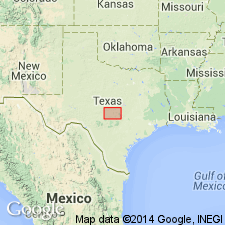
- Usage in publication:
-
- Eolian limestone member
- Modifications:
-
- Original reference
- Dominant lithology:
-
- Limestone
- AAPG geologic province:
-
- Bend arch
Summary:
Pg. 24, 31, 171-173, pl. 2, and table 2. Eolian limestone member of Pueblo formation. Blue or bluish-gray hard crystalline limestone, weathering in large rectangular yellowish-brown blocks. Average thickness is but 1 foot, and it does not form a prominent or persistent escarpment. It may be = Stockwether limestone of Drake. Is separated from underlying Saddle Creek limestone by 50 to 60 feet of shale and from overlying Camp Colorado limestone by 75 to 125 feet of shale. [Age is Pennsylvanian.]
Source: US geologic names lexicon (USGS Bull. 896, p. 693).

- Usage in publication:
-
- Eolian limestone member
- Modifications:
-
- Principal reference
- Dominant lithology:
-
- Limestone
- AAPG geologic province:
-
- Bend arch
Summary:
Pg. 103. Eolian limestone, in Pueblo formation, named from exposures near Eolian, Stephens County, central northern Texas. [Age is Pennsylvanian.]
Source: US geologic names lexicon (USGS Bull. 896, p. 693).
For more information, please contact Nancy Stamm, Geologic Names Committee Secretary.
Asterisk (*) indicates published by U.S. Geological Survey authors.
"No current usage" (†) implies that a name has been abandoned or has fallen into disuse. Former usage and, if known, replacement name given in parentheses ( ).
Slash (/) indicates name conflicts with nomenclatural guidelines (CSN, 1933; ACSN, 1961, 1970; NACSN, 1983, 2005, 2021). May be explained within brackets ([ ]).

